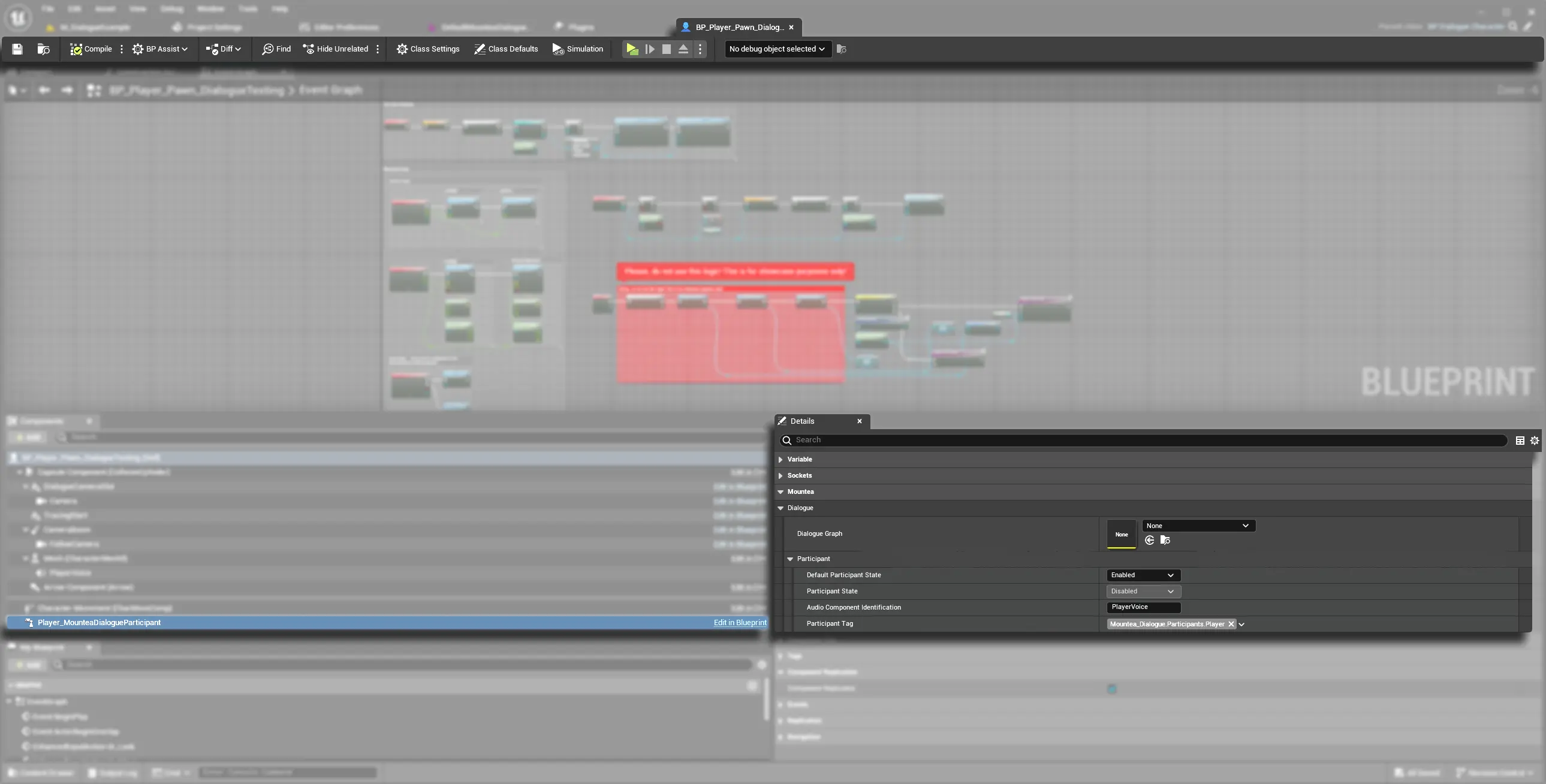Dialogue Participant Component¶
The Mountea Dialogue Participant component identifies and configures Actors that engage in dialogues, linking them to specific dialogue trees, managing participant state, and handling voice playback support.
1. What Does It Do¶
- Links Actors to specific Dialogue Trees
- Manages participant state (Ready, Active, Disabled)
- Handles Audio Component references for voice playback
- Exposes participant-specific data to the Dialogue system
2. Critical Requirements¶
Flexible Placement
Unlike the Manager Component, the Participant Component can be attached to any Actor—NPCs, environmental objects, and even the Player Pawn itself.
Player Dialogue
Your Player Pawn must have this component for full functionality and proper interaction with the Dialogue Manager.
Audio Component Recommended
It’s recommended to add an Audio Component to the parent Actor to enable dialogue voice playback.

3. Adding the Component¶
Step 1: Actor Preparation¶
For NPCs (Active Participants with Dialogue)¶
Components Needed
- Dialogue Participant Component
- Audio Component
- Visual representation (Static Mesh or Skeletal Mesh)
For Player (Active Participant without Own Dialogue)¶
Components Needed
- Dialogue Participant Component
- Audio Component
Step 2: Open Actor Blueprint¶
- Open your Actor Blueprint (e.g., NPC or Player Pawn).
- Click Add Component.
- Search for Mountea Dialogue Participant.
Step 3: Select Component Version¶
Choose between:
- Mountea Dialogue Participant – Basic C++ component.
- BP_MounteaDialogueParticipant – Pre-configured Blueprint version.
Quick Setup
The blueprint version includes default settings for the Dialogue Graph and Audio Component ID to get you up and running faster.
4. Audio Component Setup¶
- Add Component → Audio.
- Name the component DialogueAudio.
- Set Auto Activate to
false. - Add Tag
DialogueAudio. - (Optional) Attach to a mesh socket for spatial audio.
Why Audio Component?
This component plays voice lines during dialogue. Without it, no audio will be heard, breaking immersion.
5. Component Configuration¶
Dialogue Participant has a lot propertis which can be set up and/or read.
| Property | Description | Default |
|---|---|---|
| Dialogue Graph | Defines which dialogue tree this participant uses. Must not be null for dialogue to start. | nullptr |
| Default Participant State | Initial state on BeginPlay. Sets the actual State. Enum (Enabled, Active, Disabled). |
Enabled |
| Participant State | State of the Dialogue Participant. In order to start Dialogue, this value must not be Disabled. | Enabled |
| Audio Component Identification | Links the Participant Component to the correct Audio Component. Searches by:
|
empty |
| Audio Component | Audio Component for Dialogue Participant Voice. Editable using Audio Component Identification. | nullptr |
| Starting Node | If this value is valid, this Participant's Dialogue will start from this Selected Node. | nullptr |
| Traversed Path | Contains mapped list of Traversed Nodes by GUIDs. Defines what Nodes were passed through and how many tiems. | empty |
| Participant Tag | Servers a purpose of being unique ID for Dialogues with multiple Participants. | empty |
Critical Setting
Without a valid Dialogue Graph, the system cannot initiate a dialogue.
Active State Restriction
You cannot set Active as the default; it's reserved for runtime state transitions.
6. Component Events¶
Hook into these Blueprint-assignable events to respond to Participant-specific changes:
| Event | Description |
|---|---|
OnDialogueGraphChanged |
Fired when the Dialogue Graph reference is updated. |
OnDialogueParticipantStateChanged |
Fired when the participant’s state changes (Enabled ↔ Active ↔ Disabled). |
OnAudioComponentChanged |
Fired when the linked Audio Component reference is updated. |
OnStartingNodeSaved |
Fired when a new start node is saved for later sessions. |
7. Common Issues¶
Dialogue Doesn't Start
Dialogue Won't Start
- Verify Dialogue Graph is assigned and not null.
- Check that participant state is Ready.
- Ensure both Mountea Dialogue Manager and Participant components are attached.
No Audio Playback
- Confirm the Audio Component exists and is tagged correctly.
- Ensure Auto Activate is disabled.
- Check Audio Component ID matches the component’s name or tag.
Component Reference Errors
- Double-check spelling of the Audio Component ID.
- Use
SetAudioComponentin Blueprint or C++ as a fallback.